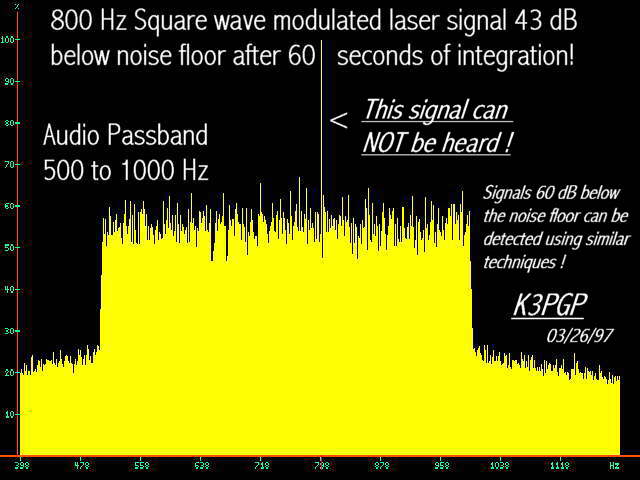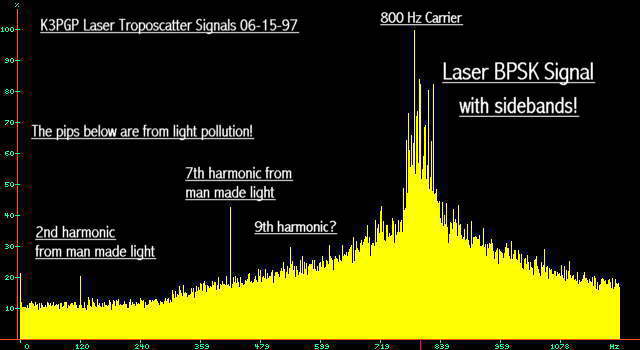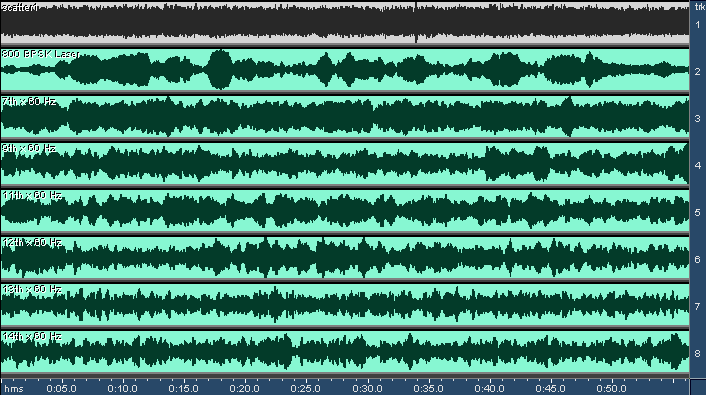K3PGP.Experimenter's.Corner
Home Astronomy Bicycle Construction Laser Moonbounce Software Guest Misc
![]()
K3PGP.Experimenter's.Corner
![]()
Home Astronomy Bicycle
Construction
Laser
Moonbounce
Software Guest Misc
Laser Audio, Video, and Charts
|
K3PGP Digital Video Files of Laser Experiments. These (VERY OLD!!!) videos were made with the CCD MB750ux 1/3 inch CCD camera. Complete specs are available on the previous page.
OK, we've all heard about bouncing laser beams off of clouds. But have you actually ever seen this being done? Well here's positive proof that this is possible using a low power 780 nm laser diode removed from a CD player!
The receive optics are a 6 inch reflecting telescope into the MB750ux 1/3 inch CCD camera. The reflection is coming from approx. 7 miles away!
Near the end of the video you will notice the laser beam jump and appear to drift down and to the left. This is the result of the cloud moving out of the path of the laser. As it moved the distance to the reflection changed causing a change in the position on the TV screen. The position change with distance is caused by the fact that the laser is side mounted on the telescope. The telescope and laser look at the same point in space but from a slightly different angle. Using this crude interferometer setup it is possible to measure distance by the position of the returned echo on the TV screen!
 (44k) Download Video of Cloud Reflection - (clouds.avi)
(44k) Download Video of Cloud Reflection - (clouds.avi)
The following file is a digital video recording done with the MB-750ux 1/3 inch CCD video camera using an 80 mm telephoto lens. The transmit laser is a 780 nm laser diode removed from a CD player! The laser is mounted on top of the TV camera and as a result the scattered light from the outgoing beam produces a cone shaped beam of light tapering to a point at infinity. This cone of light is most visible during periods of high humidity. The camera is focused on infinity. The smallest points of light are being reflected back from approx. 5 miles away!
In an effort to get the file size down the frame rate has been reduced from 30 fp/s to 10 fp/s and the video has been cropped and highly compressed.
 (175k) Download - Rain Video (rain.avi)
(175k) Download - Rain Video (rain.avi)
I ran across a very strange signal one night while out in the back yard. This signal has been heard on more than one occasion and seems to come from ABOVE the horizon! It has been suggested that this may be coming from light bouncing off of insect wings. However, the night this recording was made it was BELOW freezing. I'm not aware of any insects that are active at this low temperature. Take a listen. Really strange!
 (380k)
Download (380k)
DownloadUnknown Mystery Signal |
|
Here's another unknown signal. This one was heard coming from a cloud. The hum is NOT in the system but is coming from the cloud as well, most likely man made light coming from the ground and bouncing off the bottom of the cloud. When the laser receiver was pointed away from the cloud the hum and clicking both went away. The skies were clear except for occasional clouds and NO rain or lightning was in sight. The signal sounds man made but I'm at a loss to explain what it is! The possibility exists that this signal is being caused by some type of electrical activity associated with the cloud causing small flashes of light in the IR or UV region.
Several people have noted one or more signals in this file with an approx. period of 750 ms. I took a sample covering approx. 20 of these time periods and came up with an average period of 773.8 ms for one of these signals.
The signal was played through a DSP setup using a software gate set for a period of 773.8 ms and a gate length of approx. 3 ms. The relative phase and amplitude of the signal in question was unaltered other than to normalize the entire the waveform. Because the gate removed everything below a preset amplitude the amplitude difference between pulses appears exaggerated after the file was normalized.
This file is best 'VIEWED' in an audio editing program such as Cooledit. The original data is on the left channel and the gated signal on the right channel.
 (287k)
Download - Unknown Mystery Signal # 2 Gated (mystery2d.wav)
(287k)
Download - Unknown Mystery Signal # 2 Gated (mystery2d.wav)
I have recently been experimenting with using long term integration, DSP (Digital Signal Processing) and FFT programs to recover modulated laser signals that are below the noise floor. This seems to work very well for signals that are -20 to -30 dB below the noise floor. However, if the system is extremely stable it's possible to push these techniques down to -40 dB or more. Here's a graphic display of a laser signal modulated with an 800 Hz square wave that is -43 dB below the noise floor. After approx. 60 seconds of integration the resulting SNR is approx. + 6 dB!
 |
Long Term Integration Graphic |
Here is an example of a BPSK laser signal copied on back-scatter under CLEAR SKY conditions. The ground distance between the receiver and transmitter was approx. 26 miles and is definitely a NON-line of site path! Both the transmitter and receiver were aimed above the horizon and in the same general direction (NOT at each other!) for this test.
For those of you using the VE2IQ program COHERENT, set it for MS20 with ET on. Start the recording with the program in the sync mode till it locks up. Let me know if you are able to copy this signal! Weaker signals can be copied at slower data rates but this is about the fastest I could run the program and still get solid copy on this particular path.
![]() (440k) Download - Laser Scatter
Signal #1 - (scatter1.wav)
(440k) Download - Laser Scatter
Signal #1 - (scatter1.wav)
^^^ The laser signal is so far below the noise floor in the above recording that you may NOT be able to pick it out! It is provided as a reference weak signal for those that have the VE2IQ hardware. If your hardware is working correctly you should be able to get solid copy on this recording!
If you do NOT have any weak signal processing hardware, check the DSP processed versions of the same recording posted below.
 |
Spectrum plot of BPSK Laser Scatter Signal |
![]() (440k) Download - Above audio file processed with computer DSP
using 1 Hz filters centered on 420 hz (60 x 7), 540 hz (60 x 9)
and 800 Hz - (scatter2.wav)
(440k) Download - Above audio file processed with computer DSP
using 1 Hz filters centered on 420 hz (60 x 7), 540 hz (60 x 9)
and 800 Hz - (scatter2.wav)
^^^ Note: The 420 and 540 Hz signals are coming from man made light being scattered back from the upper atmosphere. (See the spectrum plot above.) The 800 Hz signal is coming from my 3 mw 780 nm bpsk modulated laser 26 miles away! The filtering was done using the parametric equalizer built into CoolEdit Pro. www.syntrillium.com This is an excellent demonstration of how weak signals can be processed using extremely narrow band filtering.
 |
Screenshot of Cool Edit Pro |
^^^ Screenshot of Cool Edit Pro showing the unfiltered signal from the laser Receiver, the 800 Hz BPSK laser signal, plus the 7th, 9th, 11th, 12th, 13th and 14th harmonics of 60 Hz man made light being scattered back from the atmosphere. All signals were processed with a 1 Hz wide filter built into Cool Edit Pro!
Note the fading characteristics on the man made light signals are different on each harmonic. Exactly why this is is NOT known. I would expect two or more of them to display the same fading pattern.
For information on the VE2IQ BPSK hardware and software click below for information.
![]() VE2IQ
BPSK & FFT Software / Email =
bill@ietc.ca
VE2IQ
BPSK & FFT Software / Email =
bill@ietc.ca
Home Astronomy Bicycle Construction Laser Moonbounce Software Guest Misc
Contents of this website are ©1997-98 of K3PGP and of the originating authors.